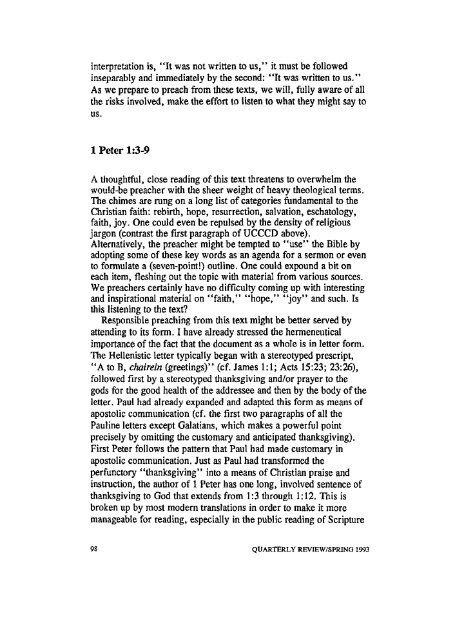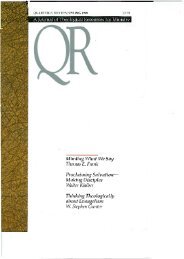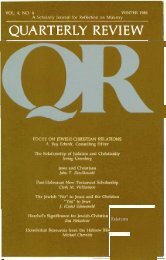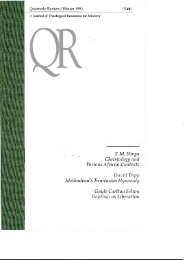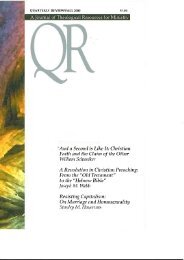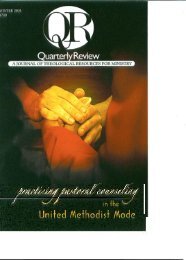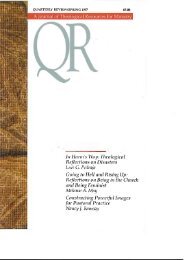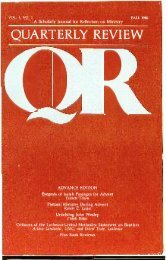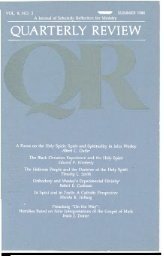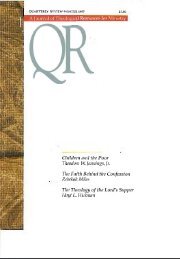TJieodore W. Jennings, Jr. The Meaning of ... - Quarterly Review
TJieodore W. Jennings, Jr. The Meaning of ... - Quarterly Review
TJieodore W. Jennings, Jr. The Meaning of ... - Quarterly Review
You also want an ePaper? Increase the reach of your titles
YUMPU automatically turns print PDFs into web optimized ePapers that Google loves.
interpretation is, "It was not written to us," it must be followed<br />
inseparably and immediately by the second: "It was written to us."<br />
As we prepare to preach from these texts, we will, fully aware <strong>of</strong> all<br />
the risks involved, make the effort to listen to what they might say to<br />
us.<br />
1 Peter 1:3-9<br />
A thoughtful, close reading <strong>of</strong> this text threatens to overwhelm the<br />
would-be preacher with the sheer weight <strong>of</strong> heavy theological terms.<br />
<strong>The</strong> chimes are rung on a long list <strong>of</strong> categories fiindamental to the<br />
Christian faith: rebirth, hope, resurrection, salvation, eschatology,<br />
faith, joy. One could even be repulsed by the density <strong>of</strong> religious<br />
jargon (contrast the first paragraph <strong>of</strong> UCCCD above).<br />
Alternatively, the preacher might be tempted to "use" the Bible by<br />
adopting some <strong>of</strong> these key words as an agenda for a sermon or even<br />
to formulate a (seven-point!) outline. One could expound a bit on<br />
each item, fleshing out the topic with material from various sources.<br />
We preachers certainly have no difficulty coming up with interesting<br />
and inspirational material on "faith," "hope," "joy" and such. Is<br />
this listening to the text?<br />
Responsible preaching from this text might be better served by<br />
attending to its form. I have already stressed the hermeneutical<br />
importance <strong>of</strong> the fact that the document as a whole is in letter form.<br />
<strong>The</strong> Hellenistic letter typically began with a stereotyped prescript,<br />
"A to B, chairein (greetings)" (cf. James 1:1; Acts 15:23; 23:26),<br />
followed first by a stereotyped thanksgiving and/or prayer to the<br />
gods for the good health <strong>of</strong> the addressee and then by the body <strong>of</strong> the<br />
letter. Paul had already expanded and adapted this form as means <strong>of</strong><br />
apostolic communication (cf. the first two paragraphs <strong>of</strong> all the<br />
Pauline letters except Galatians, which makes a powerful point<br />
precisely by omitting the customary and anticipated thanksgiving).<br />
First Peter follows the pattern that Paul had made customary in<br />
apostolic communication. Just as Paul had transformed the<br />
perfunctory "thanksgiving" into a means <strong>of</strong> Christian praise and<br />
instruction, the author <strong>of</strong> 1 Peter has one long, involved sentence <strong>of</strong><br />
thanksgiving to God that extends from 1:3 through 1:12. This is<br />
broken up by most modern translations in order to make it more<br />
manageable for reading, especially in the public reading <strong>of</strong> Scripture<br />
98 QUARTERLY REVIEW/SPRING 1993


